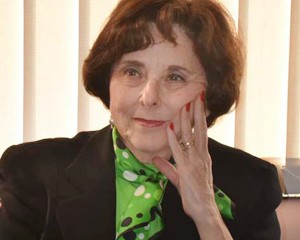A professor of Translation Studies in Concordia’s Département d'études françaises and former president of the university, Woodsworth recently released a revised edition of Translators through History, the 1995 bestseller she co-edited with Jean Delisle, Professor Emeritus of the School of Translation and Interpretation at the University of Ottawa.
Woodsworth spent almost two years on the updated version, and is proud of its popularity among students, scholars and the general public — particularly in light of the recent emergence of Translation Studies as a discipline.
The field gained increased recognition in the mid-1980s with the establishment of the Canadian Association for Translation Studies, the first association of its kind worldwide, of which Woodsworth was founding president. Still, translators’ functions both historically and at present remain unknown to many.
“A lot of people really aren’t aware of what translators do,” says the professor. “I recently bumped into a colleague who asked what I’m up to. When I said ‘I’m teaching translation,’ he said, ‘Oh, you can teach that?’ We need to keep reinforcing how complex and important the discipline is, and the role that translators play.”
Historically, that role was manifold; from inventing alphabets and compiling dictionaries to disseminating scientific and technical knowledge and influencing religious, political and cultural frameworks, translators were trailblazers who paved the course of societal progress. Paradoxically, however, translation was also at times a perilous career choice, with the social and political climate of the era dictating translators’ very destinies.
“Translators could rise to prominence, or they could be put to death. A lot of images from the Middle Ages depict translators as small figures on their knees in subservient positions, humbly offering their work to patrons — often kings — who were painted larger. There is a series of translators who were executed and burned at the stake for their work. I say to my students, ‘You think you have it bad — what about these guys!’”
More recently, translators have gained increasing recognition for their creativity and interpretive skills, says Woodsworth. “The translator is not merely copying what someone else has said, word for word. Translation is not strict imitation but a re-creation of ideas.”
Beyond updated content, Translators through History: Revised edition features a new cover image of Émilie du Châtelet, Voltaire’s lover who was a translator, mathematician and physicist. “I thought it was about time we drew greater attention to some of the women in translation,” says Woodsworth, who has lectured and presented her work in Taiwan, China, Hong Kong, Tel Aviv, and most recently, Brazil.
Woodsworth is working on a new book on the subject of authors who also translate. Like Translators through History, which is available in Arabic, Portuguese, Romanian, Spanish and soon Chinese, she plans to make it accessible to as many readers as possible — by ensuring that it is translated, of course.


 Judith Woodsworth pauses to take a question during a seminar she gave in Hong Kong.
Judith Woodsworth pauses to take a question during a seminar she gave in Hong Kong.